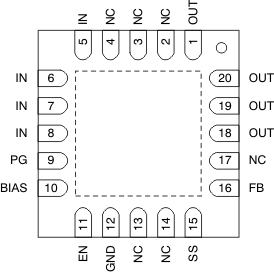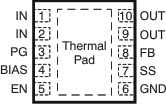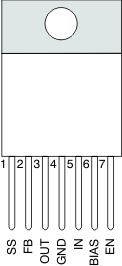SBVS082K June 2007 – June 2024 TPS74901
PRODUCTION DATA
- 1
- 1 Features
- 2 Applications
- 3 Description
- 4 Pin Configuration and Functions
- 5 Specifications
- 6 Detailed Description
- 7 Application and Implementation
- 8 Device and Documentation Support
- 9 Revision History
- 10Mechanical, Packaging, and Orderable Information
4 Pin Configuration and Functions
 Figure 4-1 RGW Package,20-Pin VQFN(Top View)
Figure 4-1 RGW Package,20-Pin VQFN(Top View) Figure 4-3 DRC Package,10-Pin VSON With Thermal Pad(Top
View)
Figure 4-3 DRC Package,10-Pin VSON With Thermal Pad(Top
View) Figure 4-2 KTW Package (Legacy Chip),7-Pin DDPAK/TO-263(Top View)
Figure 4-2 KTW Package (Legacy Chip),7-Pin DDPAK/TO-263(Top View)Table 4-1 Pin Functions
| PIN | TYPE | DESCRIPTION | |||
|---|---|---|---|---|---|
| NAME | DDPAK/TO-263 | VQFN | VSON | ||
| BIAS | 6 | 10 | 4 | I | Bias input voltage for error amplifier, reference, and internal control circuits. |
| EN | 7 | 11 | 5 | I | Enable pin. Driving this pin high enables the regulator. Driving this pin low puts the regulator into shutdown mode. This pin must not be left floating. |
| FB | 2 | 16 | 8 | I | This pin is the feedback connection to the center tap of an external resistor divider network that sets the output voltage. This pin must not be left floating. |
| GND | 4 | 12 | 6 | — | Ground |
| IN | 5 | 5, 6, 7, 8 | 1, 2 | I | Unregulated input to the device. |
| NC | — | 2, 3, 4, 13, 14, 17 | — | — | No connection. This pin can be left floating or connected to GND to allow better thermal contact to the top-side plane. |
| OUT | 3 | 1, 18, 19, 20 | 9, 10 | O | Regulated output voltage. A small capacitor (total typical
capacitance ≥ 2.2µF, ceramic) is needed from this pin to ground to assure stability. |
| PG | — | 9 | 3 | O | Power-good (PG) is an open-drain, active-high output that indicates the status of VOUT. When VOUT exceeds the PG trip threshold, the PG pin goes into a high-impedance state. When VOUT is below this threshold the pin is driven to a low-impedance state. A pullup resistor from 10kΩ to 1MΩ must be connected from this pin to a supply up to 5.5V. The supply can be higher than the input voltage. Alternatively, the PG pin can be left floating if output monitoring is not necessary. |
| SS | 1 | 15 | 7 | — | Soft-start pin. A capacitor connected on this pin to ground sets the start-up time. If this pin is left floating, the regulator output soft-start ramp time is typically 100µs. |
| Thermal Pad | — | Solder to the ground plane for increased thermal performance. | |||